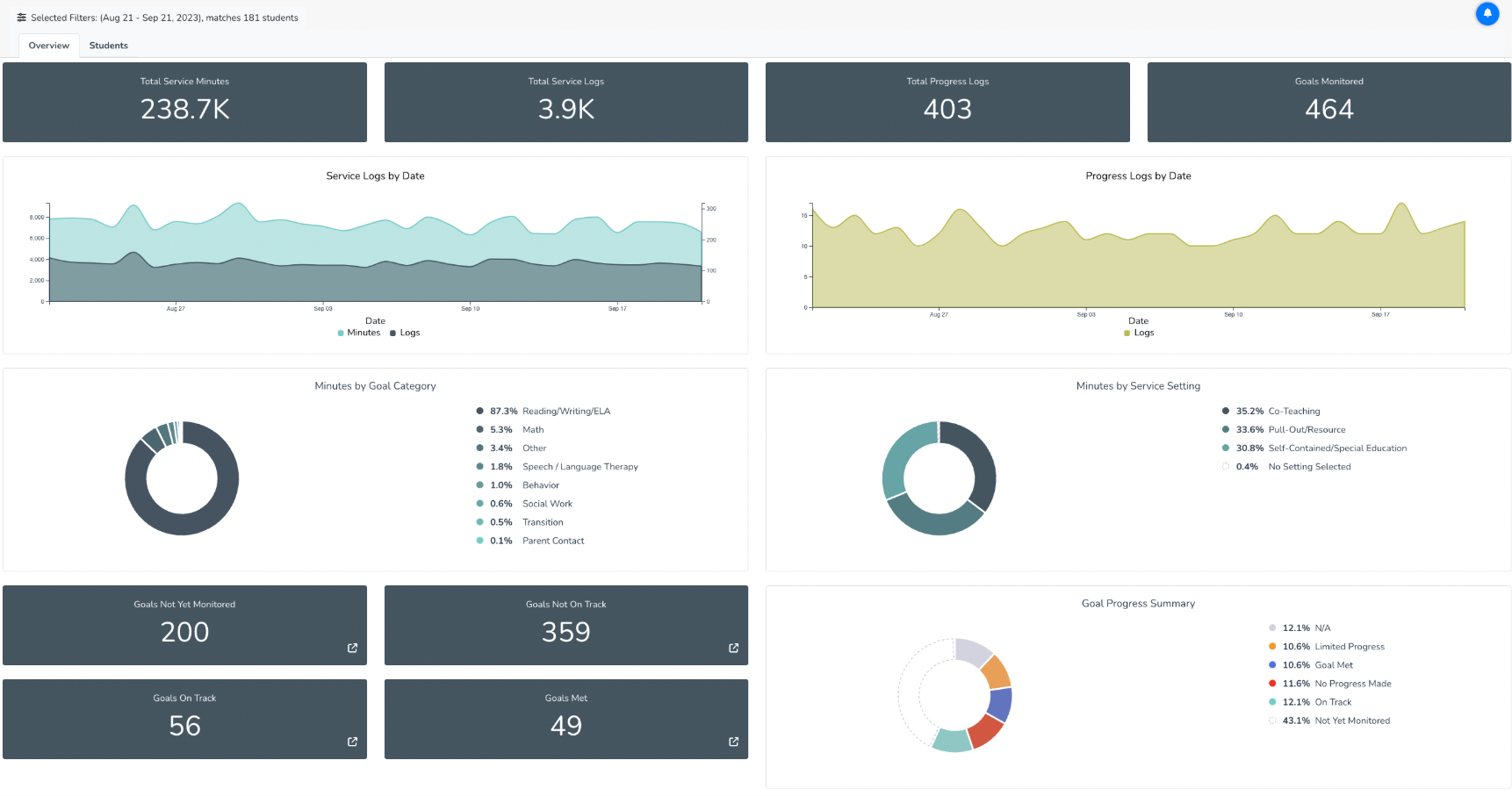
Creating Inclusive Classrooms: 3 Must-Have Practices For Student Success
Every educator wants their students to thrive, and inclusive classrooms are critical to achieve this mission. However, creating learning environments that support all learners — especially those with individual education plans (IEPs) — can be challenging for many districts.
However, some leaders have blazed a trail for fellow educators to follow, like Jaymi Brumfield, a veteran Special Education practitioner now serving as the Director of Special Education at Teays Valley Local Schools (TVD) in Ohio.
Level Data sat down with Brumfield to discover how her team advanced its inclusive classroom practices for students with IEPs. The article summarizes what we learned — watch the full webinar for more insights.
The commitments and challenges of creating inclusive learning spaces
By law, schools are required to support students with disabilities and unique learning needs — that is the whole point of the Individuals with Disabilities Education Act (IDEA) as well as similar state mandates. But Brumfield emphasizes that inclusive classrooms are in everyone’s best interest.
First, accommodations or modifications for one student often benefit others. For instance, when a teacher reads texts aloud several times or uses visual cues paired with a text, students in general education classes also better grasp the content shared.
Second, a frustrated student tends to behave in ways disruptive to the entire class. Accommodations and modifications reduce these feelings while also helping the student continue to grow.
Last, and most crucially, inclusive classrooms create a collective responsibility and community approach to help every student thrive. In this way, staff move from talking about “your” students to “our” students, taking ownership for all kids’ success, with and without IEPs.
However, establishing inclusive learning spaces isn’t always straightforward. The most common challenges include:
- Large caseloads: Specialists often assist many students with IEPs, and general education teachers may have multiple students with IEPs in their classrooms. With ongoing special education teacher vacancies and possible budget cuts on the horizon, staff may face even larger case loads.
- Lack of consistent and/or effective co-planning: Without dedicated co-planning between general education and special education staff, lessons may lack the appropriate alternatives or adjustments for students with IEPs, risking noncompliance or at least forcing educators to adjust learning “on the fly.”
- Ambiguity in accommodations and modifications themselves: In some cases, general education teachers may not have access to or understand a student’s modifications or accommodations. In others, adjustments themselves are not clearly defined, making them challenging to implement for a student.
Fortunately, as TVD demonstrates, careful planning, collaboration, and communication help districts overcome these challenges.
The power of proactive collaboration and communication
With nearly 18% of students in the district receiving services, TVD needed a better approach to consistently fulfilling these students’ IEPs and easing staff’s workload to track services. This was especially true in their secondary schools, where accommodations and modifications may not come as naturally in a classroom setting. The stakes are higher in middle and high school, too, as students need credits to advance academically and graduate.
Brumfield pointed out that collaboration and strong relationships between general education and special education staff can make a huge difference. To illustrate this, let’s follow two hypothetical students and their learning experiences within TVD’s five-level system of services.
Planning for accommodations
Marques is a 7th-grade student receiving Level 2 services for reading. His IEP outlines accommodations for reading and writing assignments. This means that he receives the same learning content as his peers, but staff adjust how he engages with it.
In a best-case scenario, Marques’s teachers share lesson plans with the reading specialist in advance, so she has time to review and prepare or offer feedback on his accommodations. For instance, in Social Studies class, students may read a text about Abraham Lincoln, then answer questions about it. The specialist would highlight key phrases or sections of that text to guide Marques towards the answers, helping him complete his assignment.
But what if this specialist walks into Marques’s classroom only to discover that students are instead taking a pop quiz about the Civil War? Even veteran practitioners with a robust toolkit of “quick” accommodations can struggle to constantly make changes without advanced notice.
Planning for modifications
Proactive co-planning is more important when students require modifications, as is the case with Cara. As a 4th grader receiving Level 3 services for math, Cara sometimes engages with the same math content as her peers, but more often, her math specialist delivers it in less frustrating ways.
Without upfront knowledge of a day’s lesson, Cara’s specialist may struggle to adequately adjust an assignment on multiplication and division in the moment. Any modifications he introduced “on the fly” add to the general education teacher’s workload, too, who must now spend time understanding what Cara did learn that day and its impact on future lesson plans or grading.
Because of these challenges, TVD encourages staff to jointly lesson plan as early and often as possible. With digital tools like shared documents or folders, teachers collaborate even when schedules don’t support face-to-face time.
Strong relationships greatly aid this collaboration. When specialists and general education teachers trust each other, they can more effectively work together to serve every student. General education teachers may be more open to receiving feedback or guidance on accommodations for a lesson from a specialist they know well. In kind, specialists can help general education teachers navigate challenges like student frustration while ensuring that student receives the support they need.
One centralized solution to capture it all
To build inclusive classrooms — not to mention remain compliant with IDEA and other mandates — districts also need effective documentation systems to manage service minutes, IEP documentation, and more. TVD adopted Brolly by Level Data over two years ago to streamline, centralize, and simplify these processes.
Brolly standardizes IEP data collection for all educators who work with students with IEPs, capturing information in one location. The solution then presents real-time information about service minutes, goal process, and compliance status to administrators.

To Brumfield, this systematic approach to capturing, tracking, and reporting on special education services reduces overwhelm for her staff. They spend less time wrangling fragmented documentation and more energy working with students themselves. Brolly also connects with most IEP systems, so a specialist can easily view their students’ goals and services even after changes have been made.
A centralized solution isn’t just a boon for TVD’s specialists. General education teachers often get left out of inclusion planning, yet they are also responsible for a student with an IEP and their success. In this spirit, TVD is expanding its adoption of Brolly to general education teachers this year.
Last, Brumfield sees Brolly and similar modern solutions as crucial for keeping all members of the IEP team informed about a student’s goals and progress, including parents. “Today’s parents are much more informed than parents of past generations,” Brumfield shared. “They have information all the time at their fingertips. We have to be more informed than our parents about student IEPs.”
Build inclusive learning environments with Brolly
In the end, inclusive classrooms benefit everyone: students, teachers, specialists, and administrators alike. Brumfield and the TVD team are eager to watch how these improvements to special education practices continue to benefit their community. She also emphasized the importance of having the right modern solution for the job:
“A system like Brolly can streamline IEPs … All those accommodations are there, so you can easily set up classes and students with IEPs … It really helps to shed light on those most commonly used accommodations, which [may be] good for an entire group of students … and which accommodations need a specialist.”
Ready to improve how you help all students to thrive and grow? Request a demo of Brolly today.
Let’s Talk
efficiency, maximize data-driven decision making, and improve educational outcomes.


